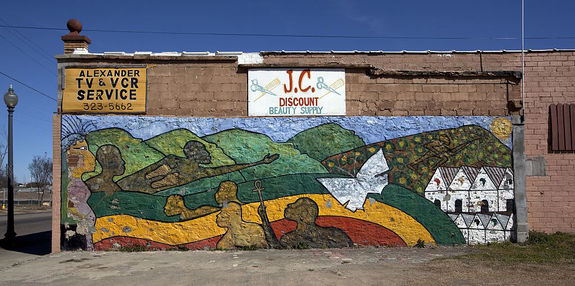Dynamite Hill: Difference between revisions
(New page: "Dynamite Hill" was the nickname of a district of Smithfield, primarily on Center Street, where a series of bombings were perpetrated to intimidate African Ameri...) |
m (Fixing link.) |
||
| (4 intermediate revisions by one other user not shown) | |||
| Line 1: | Line 1: | ||
"[[Dynamite Hill]]" was the nickname of a district of [[Smithfield]], primarily on [[Center Street]], where a | "[[Dynamite Hill]]" was the nickname of a district of [[Smithfield]], primarily on [[Center Street]], where a [[List of racially-motivated bombings|series of bombings]] were perpetrated to intimidate African Americans moving into the community and white residents willing to sell to black families. | ||
The violence flared after [[Arthur Shores]] filed a successful lawsuit overturning Birmingham's [[segregation laws|segregated zoning ordinances]]. He was representing a black client who had built a house on the "white side" of the street, but was denied a certificate of occupancy. Once a federal judge ruled the zoning unconstitutional, he was granted the certificate, but the home was destroyed by dynamite. | The violence flared after [[Arthur Shores]] filed a successful lawsuit overturning Birmingham's [[segregation laws|segregated zoning ordinances]] in [[1950]]. He was representing a black client who had built a house on the "white side" of the street, but was denied a certificate of occupancy. Once a federal judge ruled the zoning unconstitutional, he was granted the certificate, but the home was destroyed by dynamite. | ||
The unrest provoked an exodus of white families from Center Street, and, as they moved out, the only willing buyers were African Americans. The bombings continued until a group of African Americans was able to hire a white infiltrator who attended [[Ku Klux Klan]] meetings and informed residents of planned attacks. Armed men would then lie in wait and fire shots at Klansmen when they arrived. The bombings slowed considerably until the dramatic [[Birmingham Campaign]] and imminent prospect of [[school desegregation]] touched off another wave of violence, aimed at Civil Rights leaders and sympathizers. | The unrest provoked an exodus of white families from Center Street, and, as they moved out, the only willing buyers were African Americans. The bombings continued until a group of African Americans was able to hire a white infiltrator who attended [[Ku Klux Klan]] meetings and informed residents of planned attacks. Armed men would then lie in wait and fire shots at Klansmen when they arrived. The bombings slowed considerably until the dramatic [[Birmingham Campaign]] and imminent prospect of [[school desegregation]] touched off another wave of violence, aimed at Civil Rights leaders and sympathizers. | ||
[[Image:Dynamite Hill mural.jpg|center|thumb|575px|Contemporary mural on the side of a building at Dynamite Hill]] | |||
==References== | ==References== | ||
* Ridenhour, Norman Jr and Ralph Holmes (August 21, 1963) "No One Injured by Blast on Center Street". {{BPH}} | |||
* "[http://digital.wustl.edu/sho0015.0131.095 Interview with Arthur Shores]" (November 1, 1985) ''Eyes on the Prize'' | * "[http://digital.wustl.edu/sho0015.0131.095 Interview with Arthur Shores]" (November 1, 1985) ''Eyes on the Prize'' | ||
* Elliot, Debbie (July 6, 2013) "[http://www.apr.org/post/remembering-birminghams-dynamite-hill-neighborhood Remembering Birmingham's 'Dynamite Hill' Neighborhood]" National Public Radio | |||
[[Category:Center Street]] | [[Category:Center Street]] | ||
[[Category:Civil rights landmarks]] | [[Category:Civil rights landmarks]] | ||
Latest revision as of 16:05, 19 June 2014
"Dynamite Hill" was the nickname of a district of Smithfield, primarily on Center Street, where a series of bombings were perpetrated to intimidate African Americans moving into the community and white residents willing to sell to black families.
The violence flared after Arthur Shores filed a successful lawsuit overturning Birmingham's segregated zoning ordinances in 1950. He was representing a black client who had built a house on the "white side" of the street, but was denied a certificate of occupancy. Once a federal judge ruled the zoning unconstitutional, he was granted the certificate, but the home was destroyed by dynamite.
The unrest provoked an exodus of white families from Center Street, and, as they moved out, the only willing buyers were African Americans. The bombings continued until a group of African Americans was able to hire a white infiltrator who attended Ku Klux Klan meetings and informed residents of planned attacks. Armed men would then lie in wait and fire shots at Klansmen when they arrived. The bombings slowed considerably until the dramatic Birmingham Campaign and imminent prospect of school desegregation touched off another wave of violence, aimed at Civil Rights leaders and sympathizers.
References
- Ridenhour, Norman Jr and Ralph Holmes (August 21, 1963) "No One Injured by Blast on Center Street". Birmingham Post-Herald
- "Interview with Arthur Shores" (November 1, 1985) Eyes on the Prize
- Elliot, Debbie (July 6, 2013) "Remembering Birmingham's 'Dynamite Hill' Neighborhood" National Public Radio
